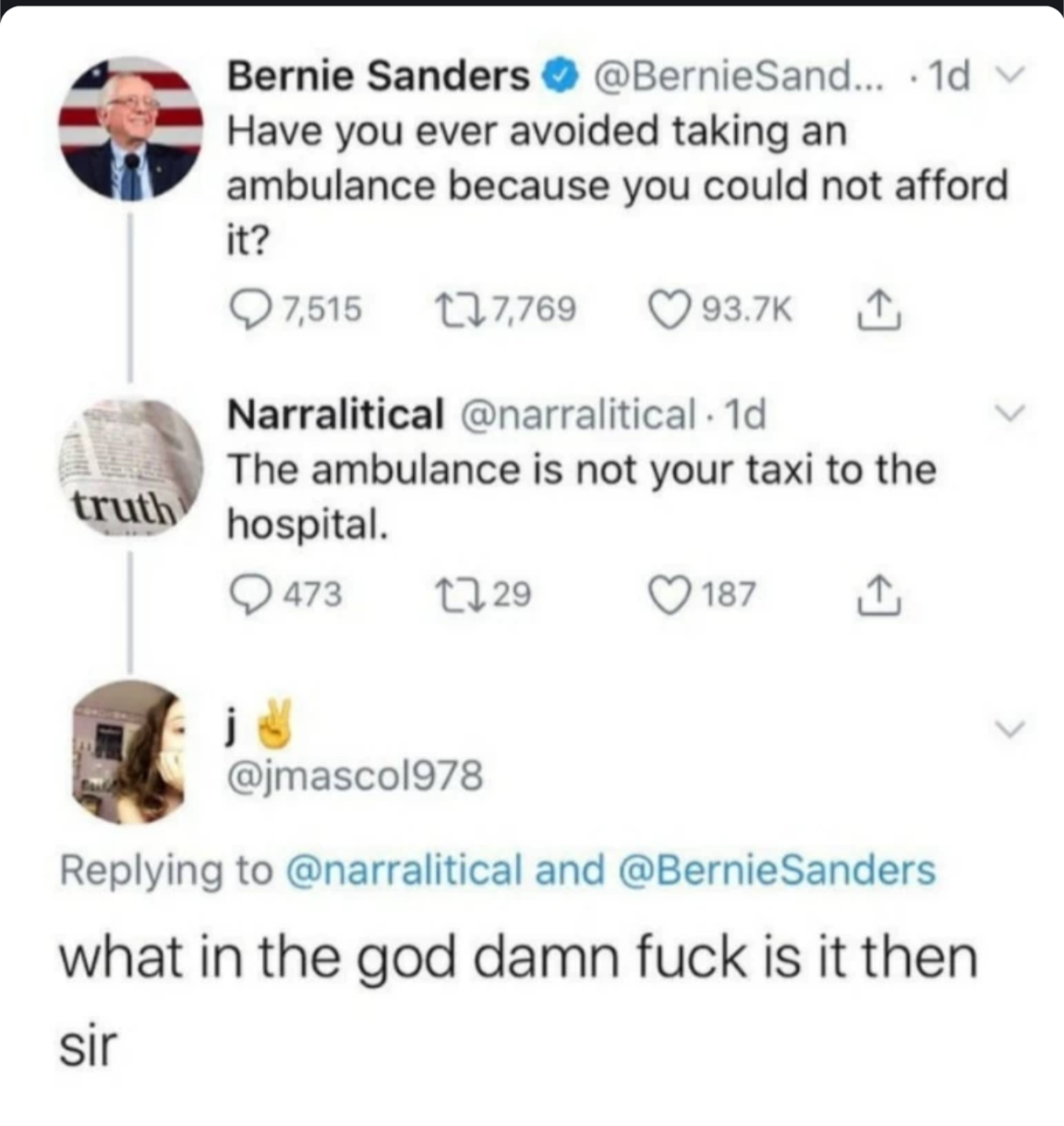Developed high speed rail since 2008 in China vs the US:

The silver lining of autocracy.
Why would a democratically elected leader plan for the long term if their sucessors, possibly from an opposition party, can claim credit for it.
In a dictatorship, they can plan for the long term, since they know they will be in power.
Also, the hyper-individualism in western countries doesn’t make “working together” as a country easier. Just look at the anti-maskers and anti-vax people lol
And also, the big population in China would never allow for a “car culture” in the firsr place, since there just isn’t room for that many cars, public transit is a must for a densely populated country.
the hyper-individualism in western countries doesn’t make “working together” as a country easier
I’d be careful with overgeneralizing that. Even though Latin American cultures also push for individualism to some extent, we do have tight-nit communities regardless because of the unified cultures that we have.
And also, the big population in China would never allow for a “car culture” in the firsr place, since there just isn’t room for that many cars, public transit is a must for a densely populated country.
I’ve been to China plenty of times, I promise the car culture is alive and well.
Eh, parking costs is a huge problem.
Its probably the reason why my parents never got a car when they were in China.
Its the same in NYC tbh. I mean, brooklyn, maybe, but if you wanna go to Chinatown in Manhattan, yea… good luck finding parking. Its not even that “Public Transit is good” (NYC subway is filthy compared to China’s subway, and also there’s no safety barriers in NYC, feels sketchy to wait for a train/subway because you get the feeling like some racist is about to push you 😕), since missing a scheduled subway/bus is gonna make you like 30 minutes late. Its just that having a car is so inconvienient in a crowded city, so much so that even the terrible public transit system is better than having a car.
Now in philly, there is street parking, and malls with parking lots… so… yea we got 2 cars in the family… 🤷♂️
We had nice things before.

the story of streetcars in the US is similarly depressing; in the 1900s most large cities had trolly systems.
the automobile companies fixed that. https://en.wikipedia.org/wiki/General_Motors_streetcar_conspiracy
Got a not potato copy? Or context?
Extent of railway development from 1860 through 1870 to 1890
Gah, America as an empire is past its prime. Look what we had!!!
And also, the big population in China would never allow for a “car culture” in the firsr place, since there just isn’t room for that many cars, public transit is a must for a densely populated country.
I’ve been to China as part of a company visit. They took us everywhere by car. Even what I would consider walking distance.
I did not see mass transit once.
That’s because you were visiting. When I was in China (as a citizen), I always had to take public transit if I want to go anywhere. My mom had to take public transit to work. Parking costs wete high, because there’s no street parking like in the US. (This was in Guangzhou btw) Now in the US, they just drive, because free street-parking is everywhere.
As a visitor, you’d of couse visit places by car.
part of a company visit.
Well that’s why… they don’t want ya’ll getting lost and your group split up.
I did not see mass transit once.
Lol where did you go? Some rural area?
Shenzen.
Okay, so I’ve never been to Shenzhen (or at least I don’t remember ever going there), but I just looked it up: https://en.wikipedia.org/wiki/Shenzhen_Metro
If you went there like… before 2010 or something, pehaps you wouldn’t see much of that, because they were kinda still building it.
The subways are all underground, so you probably didn’t notice them unless you went looking for them, it’s not like the US where some parts of the subway are above-ground, and others are underground. I have no idea how you didn’t see any of the busses tho… perhaps you didn’t pay attention to your surroundings… 😅
TLDR: Public transit exists, you either went there like a long time ago before they got built, or just didn’t pay enough attention.
Yeah, I don’t doubt it exists and probably is well used by the people living there. Just wanted to address the part of the comment saying “China would never allow for a “car culture” in the firsr place” because there sure was a car culture. It felt like an American city.
I’m also aware that Shenzen is different from the rest of China, and, well, that the rest of China is different from the other rest of China.
“China has good railways because China bad” is one hell of a bad take.
China isn’t an autocracy any more than the US is, getting to vote which party gets to erode your rights and enact genocide on your behalf isn’t democracy
Xi Jinping’s third term is literally autocracy. President Cheeto would kill for that much power.
America as fucked up as we, are can bash our president and resist his power grabs as much as our oligarchy allows.
In China, you can’t even post a whinnie the pooh cartoon because making an autocratic dictator look bad can’t fly.
China doesn’t have rapid shifts in infrastructure because China bad, it’s because China has an autocratic dictatorship which allows for massive investment of resources without argument.
The US has massive investment of resources without argument too when it comes to the military industrial complex or to rescuing banks that have committed fraud, or to genocide Palestinians. The fact that it doesn’t do so with basic infrastructure is because the oligarchs in the US don’t want that, not because of a lack of oligarchs in power. They make it theatrical in congress, but look at the defense budged and the speed with which they approve multi-billion expenses that go into bombing kids in the middle east, suddenly the American democracy works expediently.
getting to vote which party gets to erode your rights and enact genocide on your behalf isn’t democracy
what in the god damn fuck is it then sir
A democracy would be voting for a party promising not to erode your rights and getting your rights not eroded. That’s not what you get in the ol’ US of A, anywhere in the west for that master
Yeah that’s what happens when all your manufacturing is outsourced there. China is insanely insanely rich now
Still not as rich as the USA.
China’s GDP is 17.79 trillion dollars compared to the USA’s 27,36 trillion.
There’s plenty of money to invest in public infrastructure, but no one wants to do it.Yeah, just to add, per capita the difference is even starker. The low population density in the US makes it extremely costly to build a high-speed railway from east to west coast, but there is no good reason why there is no railway between LA-Bay Area-Sacremento, and a high-speed rail connection along the East Coast is a no brainer.
USA is very wealthy. It’s always a choice what to invest in.
For anyone who really likes driving:
More public transport = less people driving = less traffic = win-win situation for everyone
During rush hour my city’s transit comes every 15 minutes, 7.5 minutes on the shared line. I only used it for commuting. On the weekend I saw the train leaving and didn’t worry but had to wait a while 30 minutes. Which sucked.
Fully agree and the US public transportation system is fucking pathetic.
What is “the US public transportation system”?
some cities have amtrak and it’s expensive. there’s also the private public transit system of greyhound, megabus, and the chinatown express network
it’s taken a few decades but seattle finally has really good light rail. every 10 minutes. you can get from the airport to the other side of the city for $4. it’s not perfect, and doesn’t go everywhere, but holy hell is it a giant upgrade for living in town.
Mmmmm. Grew up in Seattle, and finally having light rail is, of course, better than not having it.
But I’ve also lived in San Francisco, and I’m often frustrated by the unreliability and mismanagement of Seattle’s system. Meltdown days seem about as common as non-meltdown days.
fo sho if you’re going to compare it to bart, which is like, 50 years of concerted civil engineering to the last two decades here in Seattle, it’s gonna fall short. Bart’s an impressive outlier in commitment to the problem.
BART was pretty impressive too, but I was mostly thinking of San Francisco’s Municipal Railway (Muni). It’s about 110 years old, and ran eight routes, cable car and light rail, when I lived there in the '00s (they’ve added a few routes since then). I didn’t have a car, and Muni took me everywhere inside the city, pretty reliably. Sure, you could count on a meltdown of the system every month or two, but Sound Transit is only 15 years old, too young to be as rickety and unreliable as it is. And it still flabbergasts me that no heads rolled over the bridge fiasco for the 2-line.
Not trying to be argumentative. Big fan of public transit. I live in Seattle and don’t own a car. Sound Transit needs to be better, is all.
San Francisco’s Municipal Railway
muni is hella awesome too, it’s a great example of how not kneecapping things in the early 1900s changes the equation.
I wish ST was better, but I have limited expectations moving here from a red state.
One of the most annoying things is cities that were designed pre-car being retrofitted for car, and then people acting like that’s the city’s fault for not making the city better for car, rather than the city’s fault for not assessing their situation and emphasizing other methods of getting from place to place
Or similarily, the whole world being walkable before the incredibly recent invention of cars and yet people still act like there’s no way to be without a vehicle. Like, even when cars were first coming out cities were already dense and had public transit that was working fine and many still do today.
Or “my town is small that’s why everything is far apart” my friend you have fewer things than I do in the city, within walking distance, and need a car to get to them all like how does that make any sense?! Put that shit together into a nice little walkable village! I’m from a village like that and I’m from goddamn Ontario! It’s awesome!
I hate when people who live in some crap suburb cannot even imagine—not even imagine; simply see—that there are better ways of doing this shit.
So many cities in North America had electric trolleys going through dense neighborhoods. Most of them got ripped out and many neighborhoods knocked down to make room for
highwaysrush hour parking lots.I watched an interesting video recently about trolleys / trams.
Originally, the form of mass transit in cities was “omnibuses”, which were horse-drawn carriages on wooden wheels with seats for many passengers. Horsecars, or horse-drawn trams, were an improvement on that. Because they used steel wheels on steel rails, they were much more efficient than wooden wheels on cobblestone streets. They required much less “horsepower” to run.
An American with the unlikely name of Mr. Train set up the first horsecars in England. What’s crazy about this first tram system is that the rails were above the road surface, and at that time there was no permit system or anything, so he’d just been installing them wherever he thought there was good business. He was eventually arrested for “breaking and injuring” a road in London, which basically stopped his efforts. Can you imagine that? Some dude just came and put regular raised railway tracks on a road and started running horsecars along those tracks and nobody stopped him until more than a year later.
Eventually they settled on grooved rails so that the trams were less disruptive of other kinds of traffic (but they can still be really tricky for bicycles). They also switched from horse-drawn trams to steam-powered trams and then to a variety of things: fossil-fuel engines, cable cars, electric, etc.
Part of what killed the tram was the rise of the car, and the push by car companies to kill their competition. But, another part of what killed them was simply rubber tires. Remember that the original advantage of trams was the superiority of steel wheels on steel tracks vs. wooden wheels on cobblestone. Modern roads and modern tires also meant that the advantage of a tram was really diminished. That meant that a lot of places started replacing inflexible trams with more flexible diesel-powered (omni)buses.
But, of course, there’s a hidden drawback that those people might not have considered. Trams use different kinds of wheels so they can get their own lanes, sometimes get their own bridges, sometimes even their own traffic lights. It’s much easier to give them priority when there are shared lanes, because they’re clearly a different kind of vehicle. When you switch from a tram to a bus, the bus is just another vehicle with rubber tires, so it gets caught in traffic in a way that trams didn’t.
And, of course, if buses have to stop frequently to load and unload passengers and they get stuck in traffic, they’re going to be much slower than cars, so it convinces people that public transit doesn’t work and they need to have a car.
In the end, we don’t necessarily need trams / trolleys / streetcars, we just need a public transit vehicle that has either dedicated lanes or priority over other traffic. Zurich, for instance, has trams, but it also has buses that get their own lanes, get their own traffic signals, and get priority over other traffic, so that drivers get out of their way or risk big fines.
Sometimes trams are the best solution. Rails means you can have multiple cabins in a row and not have to worry about how to steer around corners. With buses they can sometimes have one extra “trailer”, the famous articulated (or better accordion) bus. But, one “trailer” is really the limit. Rails also means a predictable path, which means it’s easier to make them fully electric, which generally makes them much quieter than a diesel bus. (That is, until they have to take a sharp turn).
In the end, I like trams, but trams aren’t really necessary. What’s necessary is rules that give priority to public transit vehicles. You tend to get that by default with trams, but you can do it with buses, mini-buses or even mini-vans.
Dense neighborhoods that were often similar density to suburbs.
The electric trams were bad, because they were never actually intended as transport - the electric companies just wanted an excuse to hook the neighbourhoods up to electricity, and electric trams were just their excuse for doing so. It wasn’t cohesively designed, they didn’t necessarily think it was better than cars.
Note that saying they were bad is not the same as saying they had to be bad - they were just poorly executed because they didn’t give a shit.
Or “my town is small that’s why everything is far apart”
Everything is far apart because the streets are too wide. This dates back to the 1780s, it’s actually older than cars, and it was what made people adopt cars in the first place - for instance, Manhattan already had its car-sized streets of their current size way, way before cars were invented.
In the long term, the problem is the street grid itself - squish everything closer together and everything will be nicer to walk to (because it’s human-scale), closer to walk to in the first place, and cheaper to maintain.
Manhattan had car-sized streets, sure. But, they were used completely differently.
For example, vendors would come and park their carts on the side of the street, with the wares facing the middle of the street, and people would walk up and shop while standing in the street. There were a lot more people walking and standing in the streets. And, it was a lot more common (and a lot safer) just to walk out into a street, because a horse wouldn’t typically run someone down, and when cars first came along they were very slow.
I don’t really see super wide streets as being a problem. Especially in a place like Manhattan where there are huge skyscrapers, you want wide streets so buildings aren’t in perpetual shadow. You just need to make sure to keep cars away, and to limit the speed of any remaining vehicles to something reasonable. Then the streets belong to pedestrians, as they should.
Yea, and when our neighbourhood’s main street(two way and street parking on either side) becomes pedestrian in the summer it’s awesome and full of patios. Large, lovely town squares have also existed for a long time, that’s zero excuse. You have to have more than just “human” scale, you also need to be able to handle a lot of people and a 5’ sidewalk, or maybe a 10’ street if you remove the car lanes’ width, just doesn’t cut it.
One more lane! /S
wHy Is ThErE nEvEr EnOuGh StReEt PaRkInG
In NL cities where not car focussed then some became more car focussed, we saw that that was wrong and started changing back.
Wouldn’t it be nice if this was people attitude and not “WHY SHOULD I BE PAYING TAXES FOR STUFF THAT I DONT USE”.
“WHY SHOULD I BE PAYING TAXES FOR STUFF THAT I DONT USE”.
I’m on a citizen’s advisory committee for a county’s planning and development board… this can be answered rather easily in a way most posing the question haven’t even considered. Approach the person like this: “So, you’ll never use this thing, you like driving, but I’ll bet you don’t like traffic… every single solitary person riding on that new bus/light rail line, cycling on those new bike lanes, and walking on those new sidewalks is another car you’re not going to be stuck behind in traffic. You personally come out ahead in this as well!”
Usually, they’ve never considered that traffic calming and alternative transport modes actually IS infrastructure from which motorists benefit. It’s true that private vehicles aren’t efficient as a means of mass transit, but they are convenient… it’s the convenience factor where you can get car-brained folks to have a change of heart. The more you can emphasize that these improvements to other modes can make driving even slightly more convenient, the more they’ll get on board with spending on them. Remember, these folks are already used to telling each other “I don’t mind all the construction, that extra lane on that highway is needed.” Half the time, this line of reasoning gets them on board or, at the very least, to stop outright opposing improvements.
America, the land of “i got mine”
Sorry, best we can do is shitty robotaxis and electric cars that lock you inside when they explode.
I watched a few episodes of that recent show “Paradise,” and as soon as I saw that they chose to make their giant bunker inside a mountain a fucking suburb with cars as the main form of transportation, I was like “fuck this…”
Then I remembered what time line we were on, and of course that’s exactly something that the US government would do.
Could fit several times more people by building vertically, but instead fill it up with one-family homes with a quarter-acre backyard and swimming pool. Sounds about right.
Reminder that transit will never take off unless there are written and unwritten rules of public decorum, and they are enforced. I live in New York and take the subway every day. There are obvious pros to doing so, which is why I do it, but you would have a hard time selling my experience to people not used to it. I regularly have to deal with shit you should never have to.
I’ve been to a bunch of places and probably taken a dozen different subways/metros, they are all way better behaved than here. East Asia is not even in the same ball park.
I’d like for where I lived in Denver to be simply walkable. Or safely bikable. I was living in a pretty urban area in SW Denver proper and my car was lost to a collision, so I started walking everywhere. Great area for that, theoretically - I was surrounded by Asian and Central American markets, convenience stores, liquor stores, dispensaries, local restaurants, all within about a mile. However, the major roads nearby were stroads. Crossing at crosswalks was much more dangerous than just wiring for cars to disperse and running across in the middle of the block.
Worse though, I was near a kinda fun hipster shopping and bar area, but there was this horrific freeway/highway/stroad exchange where you had to go across something like 6 roads and exit ramps. It was the most pedestrian unfriendly thing I’d ever seen, and coincidentally it divided a more affluent white section of town from the Hispanic area.
“Coincidentally”
I think Denver is the least walkable city I’ve ever been in. Was there a few years back and was floored by how hard it was to get anywhere as a tourist without a ride share
Really depends on the part of town. It definitely wasn’t built with pedestrian or bicycle access in mind when Denver expanded in the 60s-80s, but no city in the US was back then, really. If you’re in a dense area like Cap Hill, it’s great. Overall Denver is set up the same as most western cities, like LA, Phoenix, Albuquerque, but for the most part is better than those. If you want something really horrible try suburbs of Houston where they don’t even have sidewalks.
I live in downtown Denver and haven’t driven in 12+ years, and rarely (maybe 4x a year) use rideshares. I’m not sure where your plans took you, but there are many of us living comfortably in Denver without a car.
I still want self driving cars
Safe and reliable self driving cars, affordable and accessible high speed public transit, a smart grid that can handle a nationwide shift to renewables… I want so many things. But my expectations have never been lower for what we’ll actually get.
you see, if the City does that then it’s the city’s responsibility to maintain, both the infrastructure for transportation and the transportation itself. With cars, they only do infrastructure
car infrastructure is more expensive than public transportation
The US had voted against having this
I mean I can want two things.
Not having to drive myself to the hospital in a minor emergency where I’m alone would be nice, but even the friends and family discount at the local ambulance company is too expensive.
Maybe, you know, get universal healthcare instead of people relying on self driving cars for their emergency trips to the hospital?

Lmao never saw that, it’s great
But I think the solution to that is more accessible health care, not self driving cars













